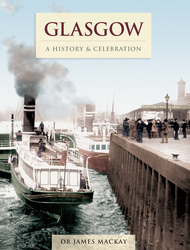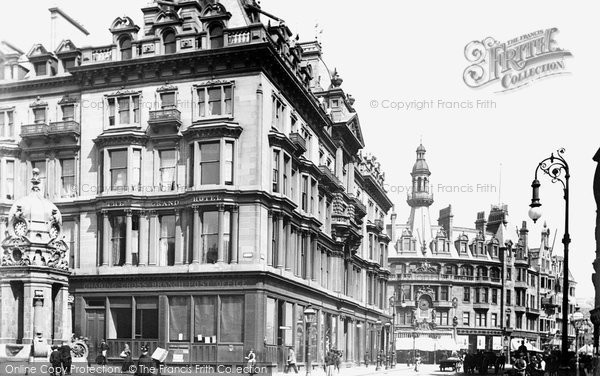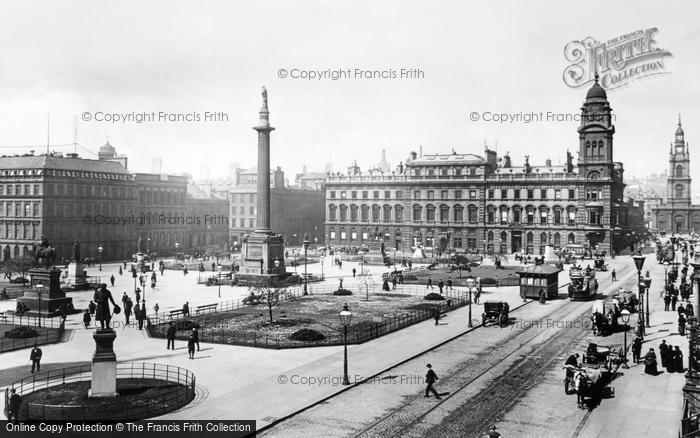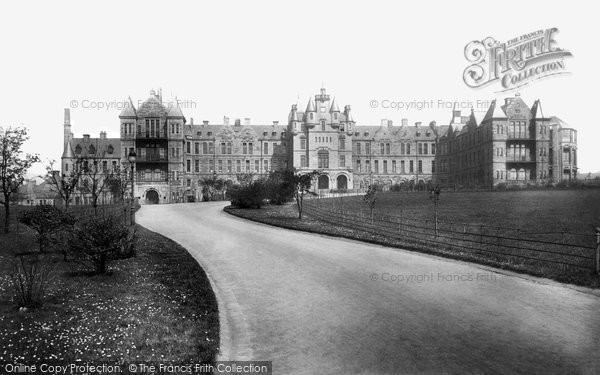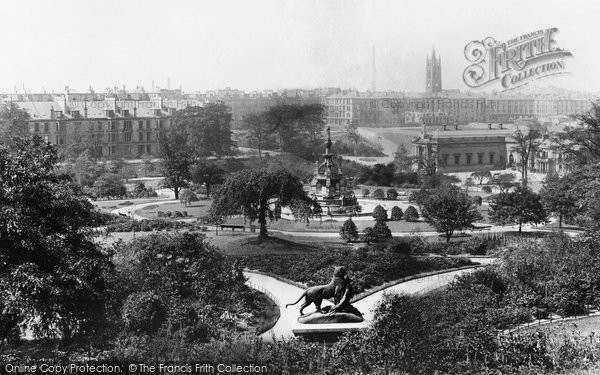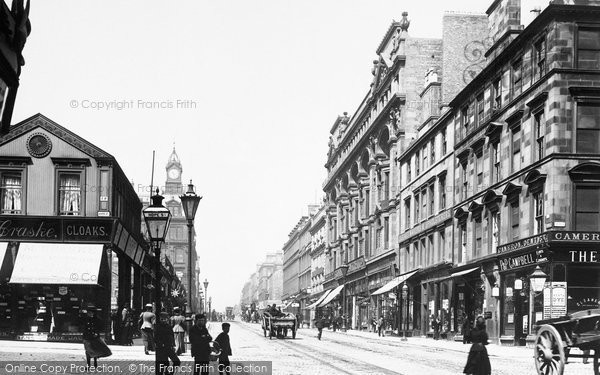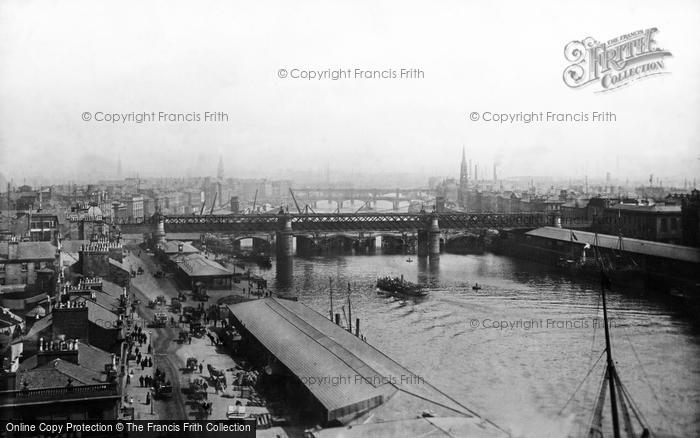Glasgow History
The history of Glasgow and specially selected photographs
The generally accepted meaning of the name ‘Glasgow’ is ‘The dear green place’, from the Gaelic form of the name, 'Glaschu'.
An elaborate statue of Glasgow’s patron saint, St Mungo, can be seen at the north entrance of the Kelvingrove Museum; the saint’s real name was Kentigern, but he was given the nickname of Mungo (‘my dear one’) by St Serf, who cared for him as a child, and it is as St Mungo that he is best-known in Glasgow. St Mungo chose Glasgow as the site for his church in the second half of the sixth century, and his portrait and miraculous symbols adorn the civic arms.
The see of Glasgow was put on a proper footing in 1125, with the erection of the first cathedral on the site of St Mungo’s original church. That structure burned down in 1175, but the cathedral was rebuilt between 1180 and 1195 and again between 1250 and 1300, resulting in the fine Gothic structure that stands to this day. The cathedral has gone through many periods of peace and strife, and on one door of the building lead shot can still be seen, which bears witness to the Glasgow citizens’ successful defence against the Reformation zealots of the 16th century who would have destroyed it. Glasgow Cathedral survives almost intact from medieval times and is said to be the most complete in Scotland, having lost only its western towers, which were dismantled in the 19th century. Below the choir of the cathedral is the crypt, part of which dates from the 1190s. In the centre of the crypt is the site of the tomb of St Mungo, and it was over his grave that the first church was erected in the 6th century.
By the time of St Mungo’s death in AD612, Glasgow may have been little more than a line of mud huts straggling southwards from the church on the site where the cathedral now stands. From Townhead you can look down the length of the High Street to the Tolbooth and the Mercat Cross, around which the medieval market town developed.
Glasgow received its first charter from King William the Lion c1175, and for the first time it was designated by the Latin term ‘civitas’ (city). A few years later the king granted Bishop Jocelin the right to hold an annual fair, a tradition that continues to this day, although by 1830 it had been transformed into a great festival for the working people of the city. The medieval fair was held at the upper end of the High Street (Townhead), but as Glasgow began to spread southward the fair moved to the north bank of the Clyde, near the Stockwell. After it ceased to be primarily a market for horses and cattle in 1818 it moved to the western end of what is now Glasgow Green, and was given over to a circus, menagerie and sideshows.
Glasgow was never a walled town, but it had four gates at the points of the compass, to control traffic. These gates were known as ports and were called the Stable Green Port (north), the Gallowgate Port (east), Brig Port (south) and Trongate Port (west). Rather confusingly, the streets were called gates (often spelled ‘gait’ or ‘yet’). East and west of the Cross were the Trongate and Gallowgate, still the principal thoroughfares leading to Argyle Street and the Edinburgh Road respectively. The Briggate, or Bridgegate, linked the north end of the bridge to the Saltmarket (originally called the Waulcergait, meaning ‘the street of the wool-scourers’), while the Drygate ran east from the cathedral and terminated on the west bank of the Molendinar.
The growth of medieval Glasgow was hampered by the rivalry of its larger and more powerful neighbours, Dumbarton, Renfrew and Rutherglen, which were royal burghs from the early 12th century and often tried to exact tolls and taxes on goods going to or from Glasgow. When Glasgow was finally raised to the dignity of a royal burgh in its own right in the early 17th century the following craftsmen were registered within its boundaries: 65 tailors, 55 maltsters, 50 cordiners (shoe-makers), 30 weavers, 27 hammermen, 27 bakers, 23 coopers, 21 skinners, 21 wrights, 17 fleshers, 11 masons, 7 bonnet-makers, 5 dyers and 2 surgeons.
Glasgow University was founded by Bishop William Turnbull in 1451. The Papal Bull establishing the university cited the advantages of Glasgow’s location: ‘the air is mild, victuals are plentiful, and great store of other things pertaining to the use of man is found’. Classes were originally conducted in the cathedral crypt, but then moved to a building in the High Street. Over the centuries this developed into a splendid structure with twin quadrangles. With the phenomenal commercial and industrial expansion of Glasgow in the 19th century this site became too cramped, so in 1870 the university sold the land for a railway goods yard - hence College Goods Station, now demolished to make way for luxury flats. A new university building designed by Sir George Gilbert Scott was built, perched on Gilmorehill above the River Kelvin. The main building consists of two quadrangles surmounted by the tower and spire completed by the architect’s son, J Oldrid Scott, between 1887 and 1891.
One day in 1765 young James Watt, an instrument maker to the university, was crossing Glasgow Green when the idea of a separate condenser for the steam engine occurred to him. He had been given a Newcomen engine to tinker with, but it was so inefficient as to be useless. Watt put his idea into practice, and converted what had been almost a toy into a machine which rapidly replaced wind and water power. It is no exaggeration to say that the Industrial Revolution was born on Glasgow Green, and an engraved boulder marks the spot.
The first bridge over the Clyde was a wooden structure erected in 1245. It was replaced c1410 by a more substantial stone bridge with eight arches. For centuries this bridge was the only one linking Glasgow to the Gorbals, Govan and Rutherglen. By the middle of the 18th century it was in dire need of repair, and Glasgow was compelled to undertake expensive reconstruction in 1776. Thomas Telford, the father of civil engineering, supervised its widening in 1821. It was dismantled in 1847 and eventually replaced by the Victoria Bridge, which opened in 1854.
By the mid 18th century the Glasgow Bridge was proving to be a bottleneck to cross-river traffic. In 1767 construction of a second bridge, at the Broomielaw, commenced under John Smeaton, the famous lighthouse builder. It was completed in 1772 and named the Jamaica Bridge, after the street that ran north from it and, in turn, reflected the importance of the sugar plantations of the West Indies to the city’s growth. Half a century later this bridge was inadequate to deal with the volume of traffic, and in 1836 it was replaced by a bridge designed by Thomas Telford. This gave way to the third and present Jamaica Bridge in 1899, although the decorative features of the Telford Bridge were retained.
In the 18th century the advent of overseas trade established Glasgow’s potential as a port and industrial centre, with the American colonies in particular. An especially important import was tobacco - Glasgow’s tobacco merchants were known as the Tobacco Lords. American requirements for textiles transformed Scotland’s linen industry to such an extent that by 1778 there were 4,000 handlooms in Glasgow alone. After the American War of Independence, the price of flax rocketed and cotton was looked upon as a viable alternative. By 1787, no fewer than nineteen cotton mills were at work in the city, rising to over 200 within a few decades. The conversion of Glasgow’s textile mills to steam power and the advent of power looms created an enormous cotton industry, and by 1830 about a third of the city’s workforce was employed in this sector alone. This phenomenal expansion had its downside, particularly affecting the handloom weavers who had earned high wages before the advent of the power looms. Men who had worked in their own homes were now supplanted by vast armies of girls working in the mills. Industrial unrest, unemployment in the aftermath of the Napoleonic Wars and wage cuts culminated in the Radical Risings of 1820. Trouble began in 1819 in the Calton district and spread to other parts of the city. The uprising in April 1820 was a feeble affair and appears to have been fomented by an agent provocateur, but 22 weavers were apprehended by the military at Bonnymuir. 19 of them were convicted and transported to Botany Bay, but the ringleaders were hanged and beheaded. In 1847 their remains were reburied at the highest point of Sighthill Cemetery, and the Martyrs’ Memorial was erected. One of these men was Andrew Hardie, great-grandfather of James Keir Hardie, the founder in 1893 of the Independent Labour Party.
Sugar was almost as important as cotton to the city’s economy in the past, and the first sugar refinery was opened in Glasgow as early as 1675. Within half a century Glasgow was the leading centre for the production of sugar, molasses and rum.
The geographical advantage of Glasgow’s position, straddling the River Clyde, meant that the Industrial Revolution in the following century resulted in a huge expansion of heavy engineering, steel and ironworks. It was the advent of steam power that saw the development of the two greatest industries in the Glasgow and Clydebank area - shipbuilding and the manufacture of railway locomotives. The shipyards included John Brown & Co of Clydebank, A & J Inglis Ltd and D & W Henderson & Co. In 1840 the Clyde shipyards were turning out about 250 tons of shipping each year; by 1865 this had risen to about 125,000 tons a year, and the amount doubled a decade later, but by 1908 it peaked at 757,000 tons per annum. The Clyde yards were extremely versatile, building every conceivable type of vessel, from luxury yachts to canal barges, from gunboats to battleships, from lake steamers to river dredges. By the 1890s a third of all ships launched in the UK came from the Clyde. Glasgow’s shipyards were at that time building battleships, cruisers and other warships fort half the world’s navies, as well as constructing the fastest, largest and most luxurious liners for the great shipping companies. Railway locomotives were manufactured by the North British Locomotive Co, an amalgamation of three companies employing 7,000 workers. In total the NBL built about 20,000 railway locomotives for customers world-wide.
Glasgow also became famous for its many public parks, theatres and music halls, and by the latter half of the 19th century Glasgow could proudly claim to have become ‘the second city of the Empire’.
Glasgow’s George Square has been said to remind visiting Londoners of Trafalgar Square, but the central column is a monument to the author Sir Walter Scott rather than Lord Nelson. The square served to emphasise Glasgow’s self-proclaimed status as ‘the second city of the Empire’. The magnificent municipal buildings around George Square were completed in 1888, including the Post Office, the Bank of Scotland, the Merchants’ House (opened in 1877) and several hotels. There are many statues of other famous Victorian figures in the square, including the only equestrian statue of Queen Victoria ever made. Her husband Prince Albert, also on horseback, is nearby.
Glasgow's old Royal Infirmary (seen in photograph 39789 in The Francis Frith Collection) was designed by Robert and James Adam and opened in 1794. The infirmary was extended several times during the 19th century, and was demolished and rebuilt in the early 20th century. It was there in 1865 that Lord Joseph Lister pioneered antiseptic surgery whilst a professor at Glasgow University, and first began antiseptic treatment; his original carbolic spray is now one of the exhibits in the university’s Hunterian Museum. The Royal Infirmary was also where Dr John Macintyre was the first person to use X-rays for diagnosis.
The din of the jackhammers and riveters of the area’s shipbuilding industry died down in the 1960s, and today only one shipyard is still in existence, Kvaerner Govan, owned by a Norwegian company. Even the amount of shipping on the Clyde dropped dramatically in the 1970s with the advent of air freight. For more than a decade the Clyde has been silent, the docks and wharves falling into decay. However, even as the heavy industries of Clydeside vanished, Glasgow was diversifying into new areas of employment, reflected in the development of high-tech industries, information technology and call-centres, and has become an important conference centre. This has resulted in an astonishing transformation of the city, particularly along the waterfront. Glasgow in the 21st century is a forward-looking city that is developing into a major world centre for sport, culture and tourism.
Further Reading
To discover the histories of other local UK places, visit our Frith History homepage.
Glasgow History in Photos
More Glasgow PhotosMore Glasgow history
What you are reading here about Glasgow are excerpts from our book Glasgow - A History & Celebration by Dr James Mackay, just one of our A History & Celebration books.
